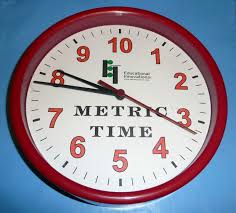 by: Martin Sagendorf
by: Martin Sagendorf
A Definition:
Clocks measure time – it can be a continuous measure of events passing or the measure of the interval between two events.
Of Hours:
After years of evolution, our modern clocks now divide the day into 24 equal length hours. And, as we know, there are two systems in use today: Americans use the “double-twelve” system while the rest of the world uses the 24 hour system.
As An Aside:
The word “hour’ comes from the Latin and Greek words meaning season, or time of day. A “minute” from the medieval Latin pars minuta prima (first minute or small part), originally described the one-sixtieth of a unit in the Babylonian system of sexagesimal fractions. And “second” from partes minutae secundae, was a further subdivision on the base of sixty – i.e. “a second minute”. (ref. Pg. 42 The Discoverers by Daniel J. Boorstin)
The “Double-Twelve” Clock Face:
Has 12 at the top – probably because at noon the sun is at its highest point in the sky.
But…
We can make a clock with 12 o’clock anywhere we wish and the clock will still work just fine.
Here we have a clock with 12:00 where 5:00 usually is. Now, if the hour hand points to 12 and the minute hand points to 2, the time would be 10 minutes past 12.

Or:
We can rearrange the face:


Or:
We can replace the numbers:



Or:
We can divide the day into ten hours (times 2).

Suitable Clocks & How to Make Your Own Clock Face:
– Good candidates are battery operated clocks with face diameters of 8 inches or less.
– There are a variety of these clocks – all I’ve seen can be disassembled if one is careful. When a front cover face must be removed, it is usually secured by three small tabs at the inner part of the face – use a worn common screwdriver to gently pry inwards, over a tab location, between the side of the cover face and the clock body – this will release the tab and allow the cover face to be gently ‘worked’ outwards. Other clock designs are held together by multiple screws from the rear – be careful, some of these have real glass for the cover face.
– The hands can be pried-off by using one’s fingernails on opposite sides of the hub of each hand.
– A new dial face should be of ‘card stock’ (8-1/2” x 11” is readily available) – standard weight paper is too light.
– A dial face must be a little smaller (1/16” on the diameter) than the opening into which it is placed – this will prevent buckling from expansion due to high humidity.
– The dial face can be hand-drawn or computer-generated (using any of the popular computer drawing programs).
– A punch or a craft knife can be used to cut out the center hole.
– Sometimes the original dial face can be removed – sometimes not – it is not really necessary. In either case, multiple small pieces of double-sided tape are used to fasten the new dial face.
– When reinstalling the hands, they must be synchronized – the easiest way to do this is to set (press on) all the hands pointing to the (original) 12:00 position.
And More:
Over the years I, and my students, have made dozens of different clock faces – there seems to be never-ending variations. You, and your students, will think of many different ones – just think of anything that represents numbers. And, what’s neat is that each individual clock can have the maker’s name and/or school name included on its face.
Marty Sagendorf is a retired physicist and teacher; he is a firm believer in the value of hands-on experiences when learning physics. He authored the book Physics Demonstration Apparatus. This amazing book is available from Educational Innovations – it includes ideas and construction details for the creation and use of a wide spectrum of awe-inspiring physics demonstrations and laboratory equipment. Included are 49 detailed sections describing hands-on apparatus illustrating mechanical, electrical, acoustical, thermal, optical, gravitational, and magnetic topics. This book also includes sections on tips and hints, materials sources, and reproducible labels.
Hi,
I am interested in a mathematical expressions clock being made for a good friend. I would like to know if you are still doing this. I have a picture that I could scan and email to you if you’d like to see it. Please let me know.
Amy
PS – In the subject line of your email, please put mathematical expressions clock.
If you were to pulse a clockwork every 730 seconds (~3^5) with a clockface displaying the 1 at top… Would seem to make an accurate
calendar display?